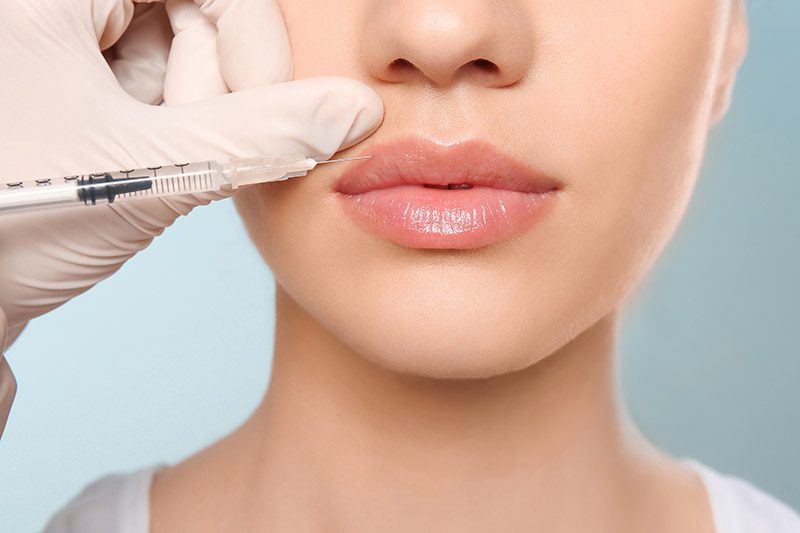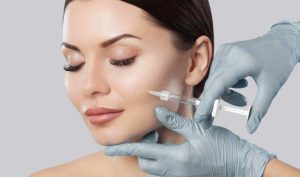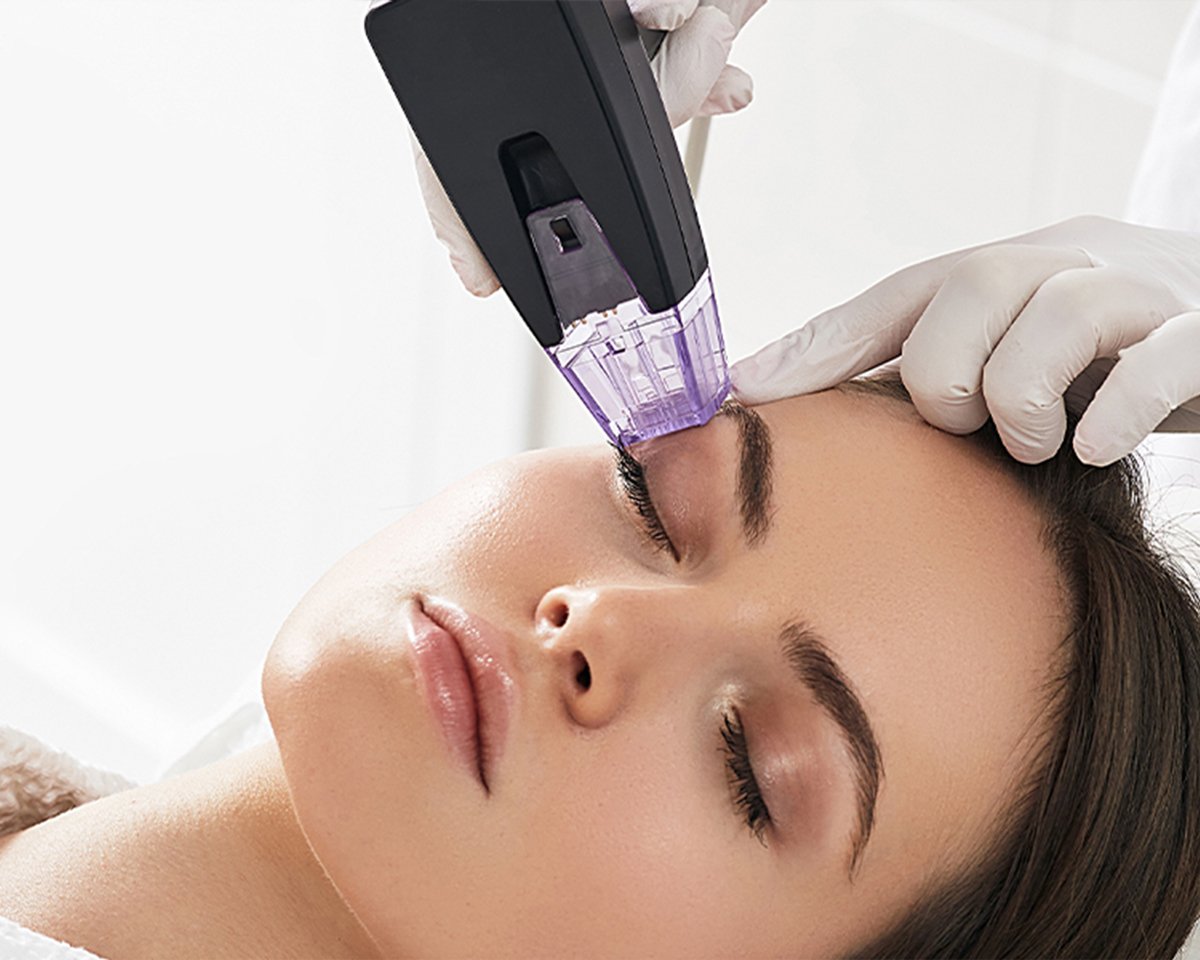
It’s fascinating to note that numerous visible signs of aging can be attributed to the loss of volume. As facial tissues naturally thin over time, fine lines tend to become more pronounced around the nose and mouth, and the cheeks may appear somewhat sunken. Dermal fillers offer a solution by replenishing lost volume, effectively reducing wrinkles, enhancing lip fullness, and rejuvenating one’s appearance. Explore the details of injectable filler treatments below to learn more.
What are Injectable Dermal Fillers?
The natural aging process results in a reduction of collagen production within your body. Collagen is a crucial protein that is distributed throughout your body, including in your skin, muscles, bones, and connective tissues. The diminished collagen levels in your skin lead to increased skin laxity, a loss of volume, thinning of the skin, decreased elasticity, and the onset of sagging.
The aging process entails a natural reduction of subcutaneous fat in our faces. This causes the facial muscles to operate closer to the skin’s surface, making smile lines and crow’s feet more visible.
The facial aging process is primarily influenced by four major structural components: skin, fat, muscle, and bone. As we age, the loss of volume in these components contributes to the emergence of various visible signs of aging.
Over time, age-related bone loss within the face can result in the retraction of the jawline, descent of the nose, and the reduction of prominent cheekbones. Concurrently, facial muscles experience a decline in volume and elasticity, and the diminishing and shifting of facial fat further accentuate the signs of aging. Finally, the skin undergoes stretching and loss of elasticity, exacerbated by the loss of structural support provided by fat, muscle, and bone. This cumulative effect results in the development of wrinkles, sagging skin, and other familiar signs of aging.
Dermal fillers and lip fillers are gel-like substances administered through injections beneath the skin’s surface to reestablish lost volume, minimize the appearance of lines and wrinkles, and refine facial contours. Over a million individuals, in all genders, opt for this widely favored facial rejuvenation procedure each year. It offers a cost-effective means to achieve a more youthful appearance without the need for surgical intervention or extended downtime.
Dermal fillers and lip fillers come in various compositions, some naturally occurring and others synthetic. One prevalent compound in dermal fillers is hyaluronic acid (HA), a naturally found substance in the skin that plays a significant role in maintaining skin hydration and volume. The duration of HA fillers, contingent on their specific composition, can vary from six months to eighteen months before gradual absorption by the body.
HA fillers offer several advantages, including their natural appearance when administered and their capacity to be dissolved using a specialized solution in cases of adverse events or if the individual is dissatisfied with the results. Most HA fillers also contain pre-mixed lidocaine, a numbing agent, to enhance comfort during treatment.
There are other available dermal fillers and lip fillers made from various materials such as calcium hydroxylapatite, poly-L-lactic acid, polymethyl methacrylate, and autologous fat (transplanted from the individual’s body). Calcium hydroxylapatite is a mineral-like compound found in human bones and has a well-established safety record from its use in dentistry and reconstructive plastic surgery. Poly-L-lactic acid is a synthetic filler that aids in stimulating collagen production, offering a gradual volumizing effect over several months. Polymethyl methacrylate is a semi-permanent filler that, while more durable, carries the risk of complications such as lumps or visibility under the skin.
Each filler material has its unique set of advantages and disadvantages, density, longevity, and texture, making certain materials more suitable for specific facial areas or desired outcomes. A medical professional will conduct a thorough evaluation of specific concerns, comprehend the patient’s expectations, and provide comprehensive guidance before, during, and after the treatment to ensure the best possible cosmetic outcome.
How can dermal fillers enhance my appearance?
Dermal fillers and lip fillers, often referred to informally as “wrinkle fillers,” offer a versatile range of benefits that extend beyond wrinkle reduction, although they excel in this area as well. Here are several common issues that dermal fillers can effectively address:
Smoothing out lines around the nose and mouth, commonly known as marionette lines, smile lines, and parentheses.
Enhancing and restoring volume to areas with sunken cheeks or temples.
Diminishing vertical lip lines.
Plumping and enhancing the lips for a fuller appearance.
Smoothing out chin creases.
Enhancing facial symmetry among various features.
Hyaluronic Acid (HA)
Hyaluronic acid is a naturally occurring substance already present in your skin, contributing to its plumpness and hydration. HA fillers are typically soft and gel-like in consistency. The results they offer are temporary, lasting anywhere from 6 to 12 months or even longer before the body gradually and naturally absorbs the particles. Most HA fillers are enriched with lidocaine to mitigate discomfort during and after treatment.

What Dermal Fillers Can Do?
Dermal fillers and lip fillers are versatile in their applications and can be used to:
- Add volume and plump thin lips.
- Enhance shallow facial contours.
- Soften the appearance of creases and wrinkles.
- Improve the look of recessed scars.
- Reconstruct facial contour deformities.
- Reduce or eliminate the shadow under the lower eyelids.
Dermal fillers and lip fillers can prove highly beneficial for individuals showing early signs of aging, and they can also serve as an advantageous complement to facial rejuvenation surgery.
What Dermal Fillers Can't Do?
In certain cases, surgical procedures like facelifts, brow lifts, or eye lifts may be the most suitable approach. Minimally invasive rejuvenation treatments, such as soft tissue fillers, may not achieve equivalent results but can be valuable in postponing the need for a facelift. It’s crucial to bear in mind that dermal fillers offer temporary solutions for facial aging, and continued treatments are necessary to maintain long-term results.
Avoid Black Market Dermal Filler
Dermal filler and lip filler procedures can be costly, which has unfortunately led some individuals to explore the online black market for do-it-yourself fillers. In recent months, there have been numerous reports in both media outlets and medical literature detailing the perilous complications stemming from self-injections of fillers by non-health professionals.
One significant risk is that fillers acquired online may contain a variety of non-sterile substances, such as hair gel. When injected, these substances can trigger allergic reactions, infections, and even the death of skin cells. Furthermore, improper injection techniques can result not only in swelling and irregularities but also in more severe side effects, such as skin cell death and embolism, potentially leading to blindness. In response to these risks, the FDA has issued an official warning, urging consumers to “never purchase dermal fillers on the internet, as they may be counterfeit, contaminated, or harmful.”
Procedure details
How Should I Prepare for Dermal Fillers?
- It is best to schedule Dermal filler or lip filler treatments at least 2 weeks, ideally 4 weeks before a big event. Results from the Dermal filler injections are usually immediate but it will take approximately 4 to 7 days to settle. Also, bruising and swelling may be apparent in that period. You may need a touch-up after 2 weeks of the treatment.
- Dermal fillers and lip fillers must not be administered if you have had any vaccines, immunizations, procedures, illnesses, or dental work in the past 4 weeks and for an additional 4 weeks after fillers.
- Avoid pain relievers called “NSAIDs,” such as aspirin, ibuprofen (generic, Advil, Aleve, or Motrin), Voltaren, and other blood thinning agents such as Vitamin E, Ginko Biloba, St. John’s Wort and fish oil or omega-3s to prevent bruising 7-10 days before the treatment. You must alert us of any medical conditions you may have and/or any prescribed medications you are taking before your treatment.
- If you are taking prescription blood thinners such as Coumadin or Plavix, you should check with the prescribing doctor to see if you can stop these medicines for 7-10 days before your appointment and at least 2 days after the procedure has been done.
- Discontinue Retin-A two days before and two days after treatment.
- If you have a current cold sore or an acne breakout on the target Dermal filler or lip filler injection area, reschedule your appointment. If you have any history of Herpes Simplex (cold sores) on your face, make sure you inform the doctor that you have made your appointment with, one week before your appointment.
- Avoid smoking and alcoholic beverages for 24 hours before the procedure as this can increase the risk for bleeding and bruising.
- Avoid waxing, bleaching, tweezing, or the use of hair removal creams in the area(s) to be treated.
- Don’t skip breakfast. On the morning of, consume plenty of food and drink as this will decrease the chances of lightheadedness during the treatment. Make sure you eat close to your appointment.
- Avoid exposure to the sun as it’s difficult to administer the treatment on sunburnt skin.
- Please come to your appointment with minimal or no make-up on the areas that are going to be treated. If worn, please remove it before treatment.
- There are no restrictions on flying but we recommend our patients avoid flights for at least 72 hours, preferably two weeks after the treatment appointment.
- Sportsmen and women should be aware that hyaluronic acid dermal fillers contain an active ingredient that may give positive results in a drug test.

What Should I Expect During Dermal Fillers Treatment?
Immediately before the actual treatment, the targeted area will be cleaned, and you may receive a topical anesthetic to numb the area before injection. Many filler products also include lidocaine, a mild anesthetic, designed to enhance your comfort during and after the procedure. Your healthcare provider will then skillfully inject a precise quantity of filler strategically beneath the skin.
Following the injection, you should typically observe noticeable results, depending on the product and areas treated. Some individuals may experience mild bruising and swelling, which are temporary and typically subside in the days following the treatment. You can typically resume your regular activities immediately after the procedure, but your cosmetic surgeon may advise you to refrain from exercise or strenuous activities for the rest of the day.
What Should I Know About Dermal Fillers Aftercare?
- Expect some redness, small pin prick marks, and minor bruising. Avoid touching the area for 6 hours after the treatment.
- Avoid disturbing the treated area (avoid touching, rubbing, massaging, or applying pressure)
- If it’s lip fillers, avoid kissing and drinking hot or too-cold drinks for 2 days.
- Stay Hydrated. Drinking plenty of water is particularly vital after dermal filler treatment, as these injectables work by attracting water molecules, thereby amplifying their volumizing effect. Avoid excessive salt for 24 hours as this can dehydrate.
- Arnica pills and/ or Arnica cream can be used to decrease bruising and swelling.
- Avoid strenuous exercise or anything that increases your heart rate for 24 to 48 hours.
- Avoid sun exposure for at least 6 hours, but recommended to avoid 48 hours. If you must go outside, use sunscreen with SPF 50+, starting 6 hours after the treatment, and reapply every 2 hours if outdoors.
- Avoid other forms of heat exposure for 48 hours, such as tanning beds, hot tubs, hot showers or baths, saunas, or cooking over a hot stove.
- Avoid sunbathing, and extremes of heat or cold for 14 days post-treatment.
- Avoid consuming alcohol for 24 to 48 hours.
- You can apply an ice pack or an ice cube covered in a thin cloth (so it doesn’t stick to the skin and cause pain) for 5-10 minutes every 2 hours. This will help ease swelling, itching, bruising, and any other pain.
- You can use Tylenol or Panadol (paracetamol = acetaminophen) for discomfort. No NSAIDs (ibuprofen, aspirin) for 24 hours as they can increase bleeding.
- Try to sleep on your back, face up, and head slightly elevated if you experience swelling.
- Avoid wearing makeup on the day of the procedure and 24 hours after the procedure. After 24 hours sunscreen and makeup can be applied, and the area can be gently washed with a gentle cleanser. Use a sensitive cleanser to avoid additional skin irritation.
- Avoid manipulation of the treated area (facials, massages, waxing, facial aesthetic treatments, bleaching, tweezing, or hair removal cream) for 2 weeks post-treatment.
- Sanitize your phone before putting it to your face and try to talk on speakerphone as much as you can the day of.
- Avoid Facial Treatments, Radiofrequency, HydraFacial, Microdermabrasion, CACI, Microneedling, and Dermaplanning treatments for up to 2 weeks to reduce the risk of complications.
- It is normal for the injection areas to be bruised and may take 7-10 days to fade.
- It is normal for the injection areas to be red and swollen for 1-3 days.
- Avoid anti-inflammatory drugs (such as ibuprofen or aspirin) or supplements (St Johns Wart, Cod Liver Oil, Vitamin A, B or E) for 2 days before and after treatment, as these can increase your risk of bruising.
When To Contact Your Doctor:
- Skin Discoloration to the treatment area or surrounds that appear purple/blue/white/grey in color. This is a sign of a vascular occlusion and requires immediate intervention.
- Increasing pain within the days following treatment
- Redness and heat to the injection site or surrounds
- Persistent itchiness with or without a rash
- Ulceration or blistering to the treatment area or surrounds
- Severe swelling that impacts normal activities (eg. eating, drinking, sleeping)
- Inflamed, hardened lumps with discomfort to touch
How Long Do Dermal Fillers and Lip Fillers Last?
The duration of the effects of dermal fillers is contingent on several factors, including the product used, the treated area, and the individual patient. In general, denser products injected more deeply tend to last longer, although this isn’t an absolute rule. To sustain your desired results, your cosmetic surgeon will perform follow-up treatments, adjusting the quantity and techniques as necessary to achieve optimal outcomes.
Hyaluronic acid fillers are typically among the more short-term options and are commonly recommended for individuals new to filler treatments. These fillers usually last from 6 to 18 months, with injections in the lips having a slightly shorter duration than those in the nasolabial folds. Specific HA fillers, such as VOLUMA, are formulated to provide longer-lasting results but are often reserved for particular areas, like the cheeks.
How often should I get Dermal Fillers?
The effects of the Dermal Filler can last for 6 months up to 18 months, and touch-up treatments may be necessary every 3-12 months, depending on the injection site and the severity of the concerns.
How Can I Avoid Looking Unnatural?
Achieving natural-looking results with fillers is certainly possible. By consulting with an experienced practitioner and adhering to a consistent treatment schedule, it’s feasible to achieve a youthful, natural appearance without stiffness. To prevent an unnatural look after dermal fillers, maintaining a regular maintenance schedule is crucial.
Allowing an extended period between treatment sessions may lead to the fillers wearing off, resulting in the return of sagging and volume loss. Staying on a regular maintenance schedule can help sustain the desired outcome and prevent a drastic change in appearance.
Does my health insurance cover Dermal Fillers?
Dermal fillers are used for cosmetic purposes, it is typically not covered by insurance. For information on coverage, it is advisable to consult with your health insurance provider to understand the specific details regarding coverage and potential reimbursement.
Image Gallery





Frequently Asked Questions about Fillers:
Transform Your Reflection: Unleash Your Natural Beauty with Dermal Fillers.
Your Skin, Decoded: Experience the Power of Digital Analysis for Personalized Skincare.
aesthetic aesthetics beauty beforeandafter dermal dermal fillers Dubai fillers injectables injections juvederm lip augmentation lip filler lipaugmentation lipfillers lips restylane skin skincare







